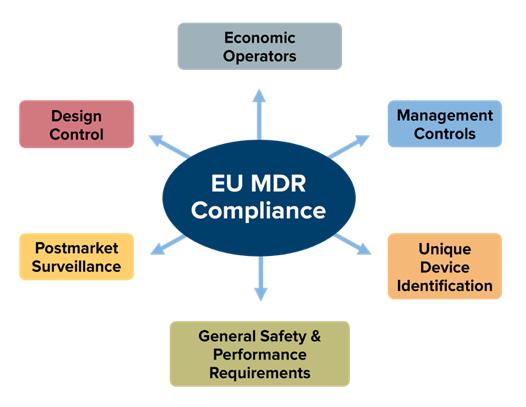Our US-based client, like thousands of other medical device companies, realized they had to act soon to be fully compliant to the EU MDR well before the May 25, 2021 deadline. The organization needed to understand the EU MDR changes, the impact those changes would have on their processes, and how this would affect their day-to-day activities. With the support of ELIQUENT (formerly Oriel STAT A MATRIX) this manufacturer developed a clear plan for addressing all aspects of the EU MDR well in advance of May 2021.
Specific client concerns
-
Understanding the impact on private labeling and the company’s own branding of finished medical devices.
-
Defining the relationship with private label partners and their roles as distributors, given the newly defined responsibilities of importers and distributors.
-
Compiling technical documentation that took into consideration changes with Annex II requirements, and then making the technical documentation accessible.
-
Changing the approach of postmarket activities to be a holistic and proactive system, taking EU distributor relationships into account.
Our approach
The client asked ELIQUENT to prepare a complete EU MDR transition plan. The intent of this project was to do more than perform a gap assessment, write a report, and walk away: The client wanted in-depth guidance, so they could fully understand timing, resource requirements, and prioritization and sequencing of the activities necessary to execute the transition.
Workstream assessment reveals hidden process linkages
ELIQUENT consultants first divided the EU MDR into workstreams. The EU MDR contains many new requirements and significant changes to existing requirements. This workstream breakdown supported the use of a process approach that allowed us to evaluate how activities were currently being conducted and how they fit together throughout the entire quality system.

Using a process-based approach, we revisited the customer’s current processes multiple times to examine their relationships. For example, when reviewing the existing Clinical Evaluation Reports, the consultants noted that there were aspects of risk management that needed to be revised as part of the clinical-risk benefit for the product. Risk management is also a key component of technical documentation that feeds into the General Safety and Performance Requirements of the EU MDR. A simple gap analysis approach may not have revealed these interdependencies and would not have fully prepared the client for EU MDR compliance.
Report provides prioritization matrix
The workstream assessment yielded a number of observations. The consultants sorted the observations into categories: system related, product related, missing documentation, or potential significant impact on released product. They then assigned an impact score of 1 to 5 to each observation that reflected the amount of resources needed, work involved, timeline considerations, and whether a current process existed. The consultants reported the observations and associated impacts in a matrix that allowed the findings to be prioritized.
A clear path ahead …
The output from the assessment was used as the foundation for a transition planning session. The exercise provided a realistic accounting of the amount of effort that would be required to complete the transition. For example, one task identified a need to review and update (as well as train employees on) all affected standard operating procedures. It was determined that this would take approximately 248 work hours (plus another 52 hours for creating new procedures). Thus, this task alone was estimated to consume 15% of an employee’s time for one year. These estimates were completed for each of the work item tasks.
The final output from the planning was an actionable, risk-based transition quality improvement plan. This plan provided detailed information on necessary tasks, interrelationships of the workstreams, acceptance criteria, and timelines for completion. All the identified activities were developed for integration into the client’s existing quality system (reference EN ISO 13485:2016 Section 5.4).
An additional benefit is that the company has a much greater understanding of the value of using a process approach when assessing organizational readiness for new requirements.
… and a competitive advantage for the company
With a solid EU MDR transition plan in place, the organization has reduced its operational risk (and its stress level). Our client knew exactly what needed to be done to achieve EU MDR compliance. Assigning priorities and using thoughtful estimates of the anticipated workload allowed them to effectively plan internal resources, establish timelines, and determine the need for external assistance.